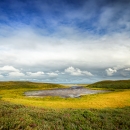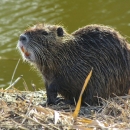Visit Us
At Cape Romain NWR, tides ebb and flow through tidal creeks of the salt marsh salt marsh
Salt marshes are found in tidal areas near the coast, where freshwater mixes with saltwater.
Learn more about salt marsh and, sandy beaches and marsh wetlands meet the maritime forest. The diverse habitats and myriad of wildlife at the refuge present numerous recreation possibilities. Fish, birdwatch, beachcomb, observe nature with the naked eye or through a camera lens, hike, hunt, and go crabbing, clamming and oystering. From dawn to dusk, the refuge is yours to experience and enjoy.
The islands and estuaries are only accessible by boat. Bring your personal boat and launch at the refuge's Garris Landing ramp. If you don't have a boat, Coastal Expeditions, the contracted concession, provides scheduled trips to Bulls Island and offers other tours on the refuge. You can fish, birdwatch, or just enjoy the view from the pier at Garris Landing.
Visit the refuge's Sewee Visitor and Environmental Education Center, located at 5821, Highway 17 in Awendaw, There, you can see and learn about endangered Red Wolves, hike the Nebo Trail, fish the Nebo ponds, and view exhibits. The Center is open Wednesday through Saturday from 9 am - 5 pm as staff are available. Please call the Sewee Center at (843) 928-3368 the day of your visit to confirm that the facility is open. When the facility is closed, the grounds are open to visitors. You may walk the trail, picnic, and view the Red Wolves at the enclosure adjacent to the trail. If the entrance gate is closed, you can park your vehicle off of the shoulder of Highway 17 and walk inside the gate.
The refuge headquarters is located close by the Center and open Monday through Friday from 8 am - 4 pm.
When you visit Cape Romain NWR and the Sewee Center, be sure to dress for the weather and pack bottled water and insect repellent.
Location and Contact Information
About Us
Cape Romain National Wildlife Refuge stretches 22 miles along the coast of South Carolina. Cape Island to the north, is located offshore from the town of McClellanville and Bulls Island, the southernmost island, is off the mainland from the town of Awendaw. Established in 1932 to conserve habitat for migratory waterfowl and other bird species, its lands and waters include barrier islands with maritime forest and brackish ponds, emergent salt marshes and vast estuaries. Over fifty percent of refuge lands and waters is a designated Class I National Wilderness Area.
Cape Romain NWR provides critical habitat and protection for a vast array of wildlife that include many bird species of concern and threatened and endangered species such as the Red knot, Piping plover, and American oystercatcher. Refuge beaches provide the largest nesting density for the northern population of the threatened Loggerhead sea turtle outside of the state of Florida. The refuge supports the endangered Red Wolf Species Survival Plan, with habitation for captive Red Wolves at the Sewee Visitor and Environmental Education Center.
Cape Romain's lands and waters are important for people as well as wildlife.The refuge is steeped with a rich maritime and coastal history as evidenced by ancient Native American shell mounds, archeological remains of a 1700's look-out tower, and two 1800's lighthouses both listed on the National Register of Historic Places. Today, people come to see and learn about the cultural history and enjoy the many recreational activities. Local commercial fishermen and women continue to earn their livelihoods in refuge waters.
Tours
Cape Romain NWR collaborates with the concession to provide cultural and ecology tours in the refuge. Six times annually, there is a tour to Lighthouse Island where you can view two historic lighthouses built in 1827 and 1857. Both lighthouses are listed on the National Register of Historic Places.
Offered once annually in late Fall is the Long-billed curlew expedition, an exciting adventure through the salt marsh salt marsh
Salt marshes are found in tidal areas near the coast, where freshwater mixes with saltwater.
Learn more about salt marsh estuaries to spot the uncommon curlew. The Bulls Island alligator tour, a guided walk over island dikes to sight these ancient reptiles, also occurs in the Fall.
Throughout the year on Bulls Island, special sunrise photography tours are scheduled, when photograhers and nature lovers arrive on the beach before predawn to witness sunrise breaking over the Atlantic. Other eco-adventure tours to Bulls include the estuary kayak paddle and island hike and, a beach drop on the secluded north end where naturalists share coastal geology and island history.
What We Do
Cape Romain NWR was established to conserve and manage habitat for migratory waterfowl and other bird species. Over time, management practices expanded to include protecting endangered and threatened species, preserving maritime forest, conserving the wilderness area wilderness area
Wilderness areas are places untamed by humans. The Wilderness Act of 1964 allows Congress to designate wilderness areas for protection to ensure that America's pristine wild lands will not disappear. Wilderness areas can be part of national wildlife refuges, national parks, national forests or public lands managed by the Bureau of Land Management.
Learn more about wilderness area and, providing opportunities for outdoor recreation compatible with wildlife and habitat management such as hunting and fishing, wildlife observation and photography, environmental education, and interpretation.
Conservation management on the refuge includes nest protection for the threatened Loggerhead sea turtle, bird surveys and protection of nesting areas for migratory seabird and shorebirds, care for the endangered Red Wolf, and measures to eradicate invasive plant species. Water control structures at impoundments are managed to maintain habitat and maximize food supplies for waterfowl, wading birds and shorebirds.
An abundance of finfish and shellfish species are found in refuge waters and fishing opportunities, both for recreation and commercial needs, occur throughout the year. All fishing activities are in accordance with the seasons and follow South Carolina state regulations and licenses. The refuge offers two archery hunts for White-tailed deer to maintain a healthy deer population suitable with the conditions and environment of Bulls Island . Federal and state regulations apply and all appropriate state licenses are required for hunting.
Our Organization
Cape Romain NWR, managing a landscape that sustains a plethora of wildlife and fish species, works collectively with federal and state agencies, conservation organizations, universities and individuals to support conservation programs in keeping with the mission of the National Wildlife Refuge System and this refuge. Programs are undertaken to restore and enhance habitat, wildlife and fish populations, migratory birds, and preserve the historic sites at the refuge.
Our Species
Cape Romain NWR protects and manages habitat for migratory and resident birds, species of high concern, and threatened and endangered species. The refuge provides abundant foraging, nesting and resting areas for over 293 species of birds that include seabirds and shorebirds, wading birds, waterfowl, raptors, and neotropical and resident songbirds. In the Spring, many bird species like the Red knot arrive on the beaches of Cape Romain to forage and replenish their energy reserves to make their journeys farther north. Others, such as the Black skimmer, Wilson's plover, Black-necked stilt, and Least and Gull-billed terns arrive on the beaches to nest and raise their young during the summer months. The American oystercatcher nests on the refuge and can be seen year-round. The largest wintering population of American oystercatchers along the Atlantic and Gulf coasts is found at Cape Romain.
Refuge forest and marsh habitats provide a haven for many mammals and reptiles as well, such as deer, bobcat, Black fox squirrel, raccoon, Diamondback terrapin and American alligator. Since 1979, the refuge has actively worked with federal and state agencies, universities, local organizations and associations, and volunteers to recover the threatened Loggerhead sea turtle. Instrumental in the recovery efforts of the endangered Red Wolf since the Red Wolf Recovery Plan was implemented in the 1970's, Cape Romain continues to actively support the endangered Red Wolf Species Survival Program.
Get Involved
Would you like to learn more about the U.S Fish and Wildlife Service and Cape National Wildlife Refuge? Moreover, would you like to help the refuge fulfill its missions of conserving and protecting our treasured natural and historic places? If so, we need You - your talents, time and enthusiasm.
From its start in 1903, the National Wildlife Refuge System has owed its very existence to concerned citizens eager to protect America's natural resources. Since Cape Romain NWR was established in 1932, conservaton accomplishments at the refuge would not be possible without the support and dedication of Partners, Friends and Volunteers. Research, surveys, outreach programs, education, resource maintenance and enhancement, and wildlife protection are all programs undertaken to protect wildlife, habitat and our cultural sites on the refuge.
Join us in our conservation mission. You can contact the refuge headquarters at (843) 928-3264 or email caperomain@fws.gov. If you are interested in a resident volunteer position, please see our opportunities at volunteer.gov.
Projects and Research
Since its establishment, Cape Romain NWR has been a living laboratory of wildlife and habitat research and initiatives for state and federal agencies, universities and conservation organizations. Vegetation studies of maritime forest, recovery initiatives for the Red Wolf and Loggerhead sea turtle, climate and sea level rise projects in the marsh estuary, air quality monitoring, and seabird, shorebird and waterfowl surveys have been implemented on the refuge and continue today. Indeed, the first studies of population and behavior patterns of the Loggerhead sea turtle were documented on the refuge in the early 1930’s and, the initial experimental releases of Red Wolves to determine whether this critically endangered Wolf could be re-established in the wild occurred on Bulls Island in the 1970s.



















